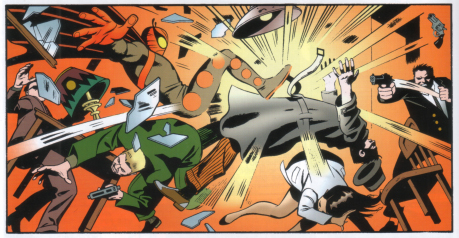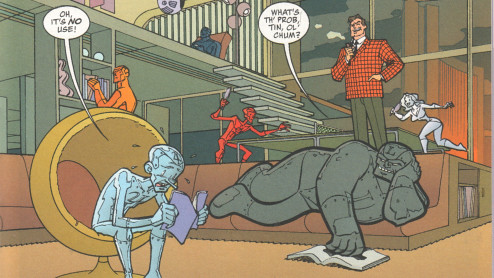First of all, I finally got my hands on a copy of the Fletcher Hanks collection I Shall Destroy All the Civilized Planets! This thing is even more of a mind-blower than I thought it was going to be. None of the work in it (with the exception of the expository strip by editor Paul Karasik) can be called good in any sense of the word: the plots of these Golden Age stories (from the sci-fi, jungle girl, and tough-guy adventure genres) are fantastic and implausible, the characters are mere stereotypes and collections of cliches, and the art demonstrates an imaginative grasp of human anatomy.
And yet - and yet there is something grand about these stories; something sets them apart from the mediocre and the mundane. It might be the energy of Hanks's art, compelling in its gusto and harshness and in the grandeur and ugliness of the figures; it might be the sheer bravado and scope of his melodrama, defying you to suspend disbelief for the frankly unbelievable and the unaccountably bizarre. Whatever they are, these comics are not ordinary, and do not fail for lack of brio.
I can't honestly say I expect anyone to enjoy reading these, but I am glad I had the chance to.
In a bit more traditional vein (and only a dada convention could be less traditional than Hanks) comes this offering from Steve Rude:

The Moth
Gary Martin & Steve Rude
Dark Horse/Rocket Comics, 2005
This collection presents five issues’ (and some additional material’s) worth of adventures of the Rude-created bounty hunter/sort-of super-hero, The Moth. By all rights, I should love this comic; it’s got so many great elements: a pulp-style mystery man who is actually a circus manager/performer, a sexy bearded lady, a bald strongman in a leopard-skin loincloth, African were-lions, Chinese acrobat jewel thieves, and a pistol-packing, star-spangled aviator named Amercian Liberty who is both a commercial spokesmodel and an FBI operative. Wow.
Unfortunately, Gary Martin’s scripts, while presenting competent plots and conflicts, seem to stop dead for exposition every now and again, totally throwing off the rhythm of the stories so we can hear Who He Is and How He Came To Be. The comic relief seems equally disruptive - the stories either take a break so the hero can get shit on him (literally) or detour to spend some time with the least funny collection of circus clowns that have ever seen print. I know this collection covers the very beginnings of the series and there s a lot of information to get across; I just wish the backstory and character bits had been incorporated a little more smoothly.
Luckily, Steve Rude’s art makes up for any shortcomings of the script. He seems to be channeling the raw power of Kirby, adding some Ditko bounce, and drawing it all like the master draughtsman that he is. His character designs are exquisite, and his action scenes practically jump off the page.

While I can t recommend it unreservedly, this book was a solid read; if you liked Dave Stevens’s Rocketeeer stories, there are probably enough chills and spills in The Moth to make you happy.
There's a phenomenon I have noticed: TV shows that aren't quite the same thing as their more famous inspirations, but rather a more lightweight treatment of same same themes in the same genre. The success of Star Wars begat Battlestar Galactica; Raiders of the Lost Ark gave us Tales of the Gold Monkey, and long ago, The Three Musketeers with Oliver Reed spawned Panache with Rene Auberjunois. Even when the heritage is more direct, the TV show seems a pale imitation: Stargate SG-1 is no Stargate.
In some ways, that also-ran vibe attaches to this comic, yet I like it a lot:

The Perhapanauts: First Blood
Todd Dezago & Craig Rousseau
Dark Horse Comics, 2006
This trade collects the first four adventures of the Bureau of ExtraDimensional Liabilties and Management's Blue Team: the leader Arisa, a telepath/telekinetic; Molly, a ghost; MG, an interdimensional traveler; Bigfoot (yeah, the Bigfoot); and Choopie, a chupacabra. The agents are dispatched to scenes of paranormal trouble (sort like in an X-files MotW episode) and try to protect the fabric of our reality from rips and the creatures who find their way through them.

You might be forgiven if you are reminded of Hellboy and the BPRD. Although haven’t been devoted follower of Earth-Mignola, I sure get the sense that if Hellboy was the big-screen blockbuster, Perhapanauts is the TV series that airs on the sci-fi network on Saturdays at midnight. This is not just a case of post hoc, propter hoc, either; the world of BEDLAM seems derivative, in theme and mood, of the Hellboy universe, and the characters are similar, but a bit sketchy and formulaic, and a little too contrived.
This feeling is made harder to shake by Craig Rousseau's art, which seems very evocative of Mignola in character design and some compositions, but without the use of heavy blacks. And although this similarity is there, there is none of the idiosyncratic style in architecture and artifacts that marks Mignola's work; Rouseau's world has a more generic comic book look. Nonetheless, he does a good job with both fight scenes and the quieter moments, and I can't really fault the art.
Todd Dezago provides some exciting action, dropping us "In Media Res" (the title of the first story) and filling us in on the cast with integrated (if still obvious) exposition that barely slows the plot at all. The menaces that the team faces are clever, and the relationships among the agents are falling nicely into place.
While nothing in the book struck me as genius, or groundbreaking, or breathtaking, I had a great time anyway. The adventures are fun, the good guys are good, and there's no gratuitous violence or T&A. It's solid genre entertainment. If this were a series, I would even stay up late to watch it.



1 comment:
Before I read a word of your review, I thought, "Someone's been biting Mignola's style." After reading your review, and seeing the similarity to the BPRD... it begs the question: Is this a straight rip off, or is it actually an homage... like Eastman and Laird's early parodies of Frank Miller. Is there any wink-wink, nudge-nudge for the reader?
Post a Comment